 Agriculture is not to blame for the drought. A drought by definition is below average rainfall and the reason why the drought affects our drinking water is because of an over reliance on surface water to supply our municipalities with domestic water.
Agriculture is not to blame for the drought. A drought by definition is below average rainfall and the reason why the drought affects our drinking water is because of an over reliance on surface water to supply our municipalities with domestic water.
Whilst water used by agriculture is high, there are some points worth mentioning
JOBS: About 8.5 million people are directly (638 000 formally employed) or indirectly dependent on agriculture for employment and income. The figure is so large because it takes into account dependents of farm workers.
WATER USE: South Africa is a large country, about a third of the size of the USA, however only 3% of the country has truly fertile soils and only 13% of the land being good for cultivation, while 69% is only good for grazing. This makes livestock farming the largest and highest income generating agricultural sector.
- Dryland/Rainfed = large area and low yield
- Irrigated = small area and higher yield
Dryland/Rainfed crops are not included in this 60%. In 2000, agriculture was responsible for 94% of total water consumption in South Africa when considering soil water (rainfall) with 66% for dryland and 16% for forestry. When soil water is excluded, the agriculture is the main consumer (62%) followed by urban domestic use (14). Irrigated agriculture is the largest single user of water in South Africa (60%) and it has a huge potential socio-economic impact in rural communities.
IRRIGATED MAIZE STATISTICS: Irrigated maize is only a small percentage of total hectares for maize, but it contributes a larger percentage to the maize produced because of the higher yield from irrigated crops. Out of the volume of maize irrigated, 29% is irrigated by groundwater based on the WARMS registered water use. The 2011/12 ratio of areas planted is 61% white maize (human) to 39% yellow maize (animal). An estimated 4,7% of the area planted to white maize is under irrigation and 95,3% is dryland, while the estimate for yellow maize is 15,4% under irrigation and 84,6% dryland. A big user of water is lucerne. Lucerne (also known as alfalfa) is predominantly used for livestock feed and needs to be irrigated. It is one of the most common feeds for the dairy industry. So although livestock feed (lucerne, pastures and some maize and wheat) use a lot of water, it is still less than 25% of the total water used in irrigated agriculture.
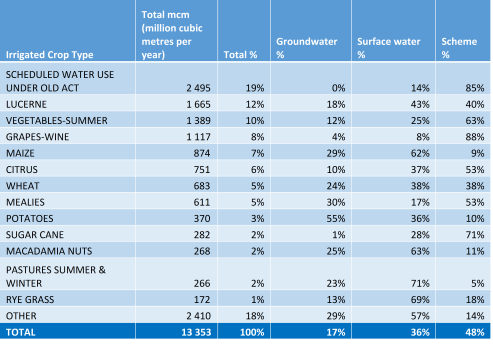
CROP AND ANIMAL WATER FOOTPRINT: The Table below from WWF-SA summarises the global water footprint of various crops. Green water is soil or rain water, blue water is irrigated water, and grey water is water polluted by the activity. So although Maize has a high global water footprint 77% of the water is from rain water and soil water. On the other hand, sugar cane, apples and nectarines have a much higher irrigated water footprint. Potatoes on the other hand have a much higher grey water footprint. Another issue with potatoes is that after harvesting the potatoes the field needs around 2 years to recover. In some instances, farmers plant maize and in other instances they leave the ground uncultivated so the soil recovers its nutrients quicker. TOFU has a global water footprint of 926 litres/kg, excluding importing the product from overseas suppliers.
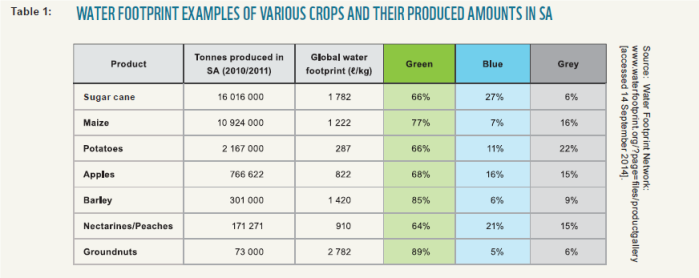
From http://awsassets.wwf.org.za/downloads/wwf006_ffl_report_low_res.pdf
Now where it becomes really interesting is when you look at the global water footprint and the nutritional content in order to calculate the water footprint (litres) per gram of protein when looking at red meat substitutes. Nuts have a higher water footprint per gram of protein compared to red meat, so you would be using less water if you had a packet of biltong than a packet of almonds for your protein. Nuts also contain more calories than beef. What is even more interesting is that eggs, chicken, pigs and sheep/goat meat have a low water footprints per gram of protein. Just note that these include the total water footprint, which includes rainfall/soil water and irrigated water.
Shelled almonds have Global Water Footprint of 16 095 m3/ton (Green: 9264, Blue: 3816, Grey: 3015), which is higher than Beef. Beef’s largest water footprint is from rainfall (green) compared to Almonds which have a higher irrigation footprint and pollution footprint. 80% of the worlds almonds come from California which is suffering a severe drought and the amount of water required for irrigation of almonds would be sufficient to supply 75% of the states population with drinking water, but because of water rights issued in the 1990s it has become a legal battle between farmers, citizens and the federal government over the water use.
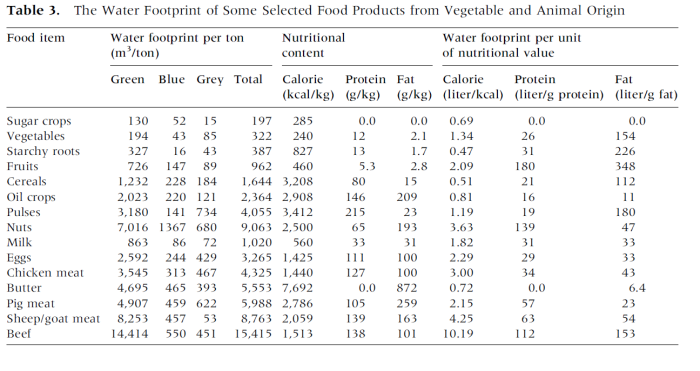
From http://waterfootprint.org/media/downloads/Mekonnen-Hoekstra-2012-WaterFootprintFarmAnimalProducts.pdf
FOOD SECURITY: When the rains fail the dryland crops fail while the irrigated crops continue to produce. During a drought the irrigated maize is vital to food security for human and animal consumption. Because of the failed crops, maize becomes scarce and the price increases. It then becomes an economic trade-off between using our scarcer water to produce our own crops or having to import maize from other countries who might be producing a surplus of maize. This would require further economic analysis to look at the cost of groundwater development, desalination, water recycling for municipalities (which would free up water for irrigation) versus the cost of importing food during a drought (PhD anyone?) The cost of water conservation and demand management is negligible which is why saving water is cheaper than having to import grains and meat. If we don’t save water we can expect to pay even more for our food and meat.
WATER SECURITY:
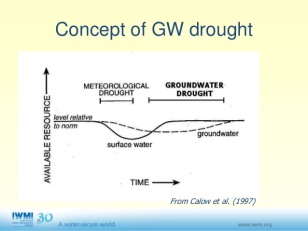
Because our municipalities require surface water for domestic supply, they are in direct conflict with agriculture for the same source of water. During a rainfall drought, irrigation should be predominantly with groundwater and not surface water. Groundwater droughts have a lag time behind meteorological droughts so groundwater can be exploited during the meteorological drought, and after the drought has broken then groundwater should be allowed to recover as surface water becomes more abundant.
FARMERS AND DROUGHT: Farmers understand this cost because it is cheaper to slaughter their cattle then it is buy livestock feed at elevated prices during a drought, especially the small scale farmers who do not have the capital and equity that the commercial farmers have access to. After the drought, if the farmers are not insolvent, they can start to rebuild their cattle stock when the price of livestock feed return to affordable prices or they can produce their own feed for their cattle. Farmers, who rely on the environment for their livelihoods are acutely aware of the drought and directly impacted by the drought as their crops fail (or reduced yields if irrigated) and livestock slaughtered with no source of income until government bailouts or insolvency occurs, while people in cities complain about water restrictions and not being able to use to wash cars, water gardens and fill the swimming pools. Let’s kick them when they are down and blame them for the drought too.
Not all Farmers are the same. Farmers are diverse as are their water use efficiencies. South Africa has some of the most water efficient farmers and some of the most water inefficient farmers. This is not a situation which is unique to South Africa. Even more baffling to me is rice grown for export in the Sacrimento Basin in California, USA, not only during a severe extended drought, but in an area which frequently has droughts.
SO WHAT CAN YOU DO?
Buy Grass-Fed beef. Grass-fed beef eat only grass and thus eliminate the need to irrigate crops for livestock feed and have a much smaller water footprint.
Eat lamb and mutton instead of beef. Typically lamb and mutton graze on natural vegetation and do not rely on irrigated crops, resulting in a lower global water footprint.
Do not go nuts about nuts. Nuts have the highest global water footprint after beef but in terms of blue water (irrigated water) footprint that are almost three times higher than beef and any other crop and animal product. As a protein substitute they have a very high water footprint per gram of protein. It also takes 4.2 litres (1.1 gallons) of water to grow a single almond, 80% of which comes from drought stricken California. The amount of water used to irrigate almonds in California would supply 75% of the states population with adequate drinking water.
Buy local. Do not buy imported products when locally grown products are available. This specifically applies to protein substitutes like tofu and almond milk. All you are doing is removing South African jobs, increasing your carbon footprint and transporting your water footprint to another country to deal with.
Do not buy imported meats. Brazil, Netherlands and the UK are the top 3 exporters of chicken to South Africa, with the EU accounting for over 60% of the exports. Why is South Africa importing cheap chicken when the South Africa chicken industry is retrenching workers? This is the socio-economic impact of not buying local. Just don’t do it.
Eat less red meat. Yes, eating less red meat will reduce your water footprint, provided you stick to buying local alternatives so that the 8.5 million South Africans that are dependent on agriculture are still able to put food on their tables.
Don’t waste food. 34% of all available food is wasted 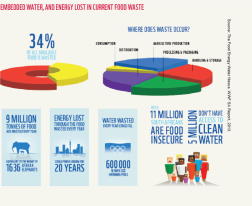 while it is estimated that up to 1/3rd of household food waste is by consumers because they don’t understand the difference between the “sell by”/”best before” and “use by” dates. “Sell by”/”Best before” means quality and “use by” means safety. It is safe to consume food after the “sell by”/”best before” provided it has been stored properly. Consuming food after the “use by” date is risky. Read more here.
while it is estimated that up to 1/3rd of household food waste is by consumers because they don’t understand the difference between the “sell by”/”best before” and “use by” dates. “Sell by”/”Best before” means quality and “use by” means safety. It is safe to consume food after the “sell by”/”best before” provided it has been stored properly. Consuming food after the “use by” date is risky. Read more here.
From http://awsassets.wwf.org.za/downloads/wwf006_ffl_report_low_res.pdf
Interesting Reading:
Water Footprints of crops (paper): http://waterfootprint.org/media/downloads/Mekonnen-Hoekstra-2011-WaterFootprintCrops_1.pdf
WWF-SA Farming Facts and Futures: Reconnecting South Africa’s food systems to its ecosystems: http://www.wwf.org.za/media_room/publications/?13821/farming-facts-and-futures
WWF-SA Agricultural Facts and Figures: http://awsassets.wwf.org.za/downloads/facts_brochure_mockup_04_b.pdf
WWF-SA Tips for tucking into SA’s enormous food waste problem: http://www.wwf.org.za/?20061/food-waste-tips
Department of Water and Sanitation’s National Water Resources Strategy 2013: https://www.dwa.gov.za/nwrs/NWRS2013.aspx
Department of Agriculture, Forestry and Fisheries Food Security Statistics: http://www.daff.gov.za/daffweb3/Links/Related-Links/Food-Security-Statistics
Water Footprint Network: http://waterfootprint.org/en/
Your point about nuts clearly makes sense, however you make no comment about pulses. According to Table 3 pulses have lower litres/calorie *and* litres/g protein figures than any of the meats, eggs or milk.
LikeLike
That is correct, but from a pollution perspective pulses have the highest grey water footprint than all of the animal and vegetable products. Pulses pollution footprint is 5 times larger than the amount of water used to irrigate it. Nuts on the other hand has a pollution footprint of half the water used to irrigate it. So from a water pollution perspective pulses are bad. You can decrease your water footprint but increase your pollution footprint.
Note: Not all pulses are farmed the same but I haven’t found a study that separates out the pulses.
LikeLiked by 1 person
OK, thanks for the insightful reply 🙂
LikeLike
I don’t know why the grey water footprint is so high for pulses. The literature seems rather vague about that.
LikeLike
Hi Ashton, thanks for the interesting read. I have two questions:
1) Why did you use water per gram of protein in your analysis instead of water per klio-calorie or calorie? 2) What is the grey water footprint of meat (for instance beef) against that of pulses (useful to have a sense when considering alternatives).
Thanks, Kevin
LikeLike
Hi Kevin, thank you for the interest!
1) I was responding to an article that what promoting protein substitutes to beef, which is why I focused on on the water footprint per gram of protein.
2) Grey water for beef is 451 m3/ton compared to pulses which is 734 m3/ton. In terms of irrigation beef requires 550 m3/ton and pulses 141 m3/ton. Other articles have almonds (shelled or peeled) at 3015 m3/ton, chickpeas at 981 m3/ton and lentils at 1060 m3/ton. Grey water for sheep/goat is 53 m3/ton because they typical graze on vegetation rather than feed a diet of cultivated feed food. I want to unpack this in my next article and explain why the legumes have higher grey water footprints. Also note that the grey water footprint is based on the volume and competition of feed for animals and doesn’t include the waste produced by the animals. This would be another reason to move away from lot-fed cattle to grass-fed grazing cattle. Pig lots in particular are one of the biggest sources of nitrate pollution for groundwater because of the nitrates in the concentrated manure which flushes its way down to the groundwater after rains.
It doesn’t make it easier for the consumer to make choices. In South Africa, because we are water scarce, pollution is always an issue. The solution to pollution is dilution, but because we don’t have enough rain under normal circumstances (never mind a drought), the grey water footprints are very important in South Africa. The nitrates work their way into the groundwater and rivers and dams which can contaminate drinking water supply and cause algae blooms in our dams.
It is a lot to think about when going shopping, especially the socio-economic effect of our actions when we buy imported products. For example buying cheap frozen chicken and the resulting retrenchments that Rainbow Chicken is being forced to do. The job losses impact families and the social fabric of communities and South Africa as a whole.
LikeLike
Thanks Ashton, I appreciate the comprehensive response. I look forward to more unpacking of the grey water issue. I suspect that calories is probably a more useful base for comparison than protein, because protein will probably vary more than calories in in high meat vs low meat diets, while still meeting daily requirements for protein with both.
LikeLike